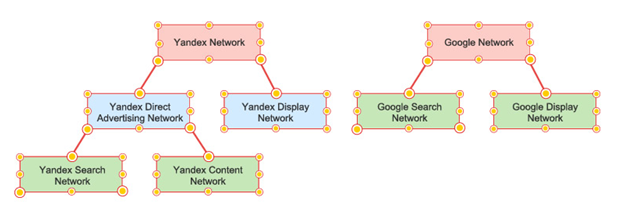Advertising online has gained many new names over the last decade. It is no longer as basic as having your static ad displayed on a single website for a fixed amount of time and money.
The options available to digital marketers are now much more sophisticated and allow you to target not only single website placements but whole advertising networks in a variety of display and payment models.
Understanding the terminology and options used in one search engine is one thing. Learning about the sophisticated differences between different search engines is like playing “spot the difference” – if you are good at paying attention to detail, you will win!
As the official trainer on the Yandex Direct platform, I repeatedly see that PPC Specialists who started their career working with Google AdWords campaigns, assume that the settings named similarly in Yandex will have very similar functions to the platform they already know. This, however, can lead to fundamental mistakes in campaign set ups, defining audience reach and optimisation efforts.
In a previous blog article, I already touched on the large differences between Yandex and Google match types and how misunderstanding this subject could narrow your audience. Today, I am going to abolish misleading assumptions about advertising networks in both search engines.
First things first, let’s define what both search and content advertising mean. If this sounds too basic for you, do bear with me. It needs to be done first to get the terminology right!
%GC_SERVICE=468%
Search advertising
Search advertising requires search engine users to type specific words into the search box in order to see the search results related to what they are interested in finding. Knowing how people search for the terms describing your product will help you establish the keywords to bid on and therefore define your audience.
However, this type of advertisement is not limited to only the specific engine’s search result page. In Google’s example, your ads will also be displayed on Google Shopping, Google Images, Google Maps and Google Groups websites.
In addition, Google by default, unless you disable it, will display your ads on the “search partners” sites – websites which use the Google search box to display search results. An example of this type of site would be AOL.
So, here is the Google network described in a graphical way:
Google clear? Let’s move on to Yandex.
By default, your search ads will be displayed in Russia on the Yandex search results page, Yandex Market, Yandex Maps, Yandex Blogs and the “Yandex search sites”. Basically, everywhere where there is a search box.
Yandex search sites are those whose owners partnered with Yandex to display ads set up in the Yandex Direct interface. For example, your ads may be displayed on livejournal.ru, Bing and mail.ru – the leading web portal in the Russian internet. Your ads will be shown above search results on those pages. I was pretty amused to find out that Bing was part of this network although traffic coming from Russia via this search engine is marginal.
By default, in contrast to Google, you cannot disable the search network as a whole. However, again in contrast to Google, you have the option to disable selected search network sites allowing you to focus only on those which bring you desirable results. Bear in mind that there are few pages which cannot be disabled at all, mail.ru being one of them.
To summarise
Your ads will appear on the Google search results page, Google Shopping, Images, Maps and Groups as well as search partner sites such as AOL. You can disable all search partners but not each one individually.
When you de-select “Include search partners”, your ads will be eligible to show on Google search and Google Shopping only.
Yandex
Your ads will appear on the Yandex search result page, Yandex Maps, Blogs and Market as well as sites from Yandex search network such as mail.ru but there is no option to disable the search network as a whole.
One thing to bear in mind – the Yandex search network is massive! Looking through the performance of each page should find a place on your everyday optimisation list of tasks, especially if you wonder why your click-through rate (CTR) is lower than in Google!
Content advertising
Search network covered, we will now move onto the content networks.
Important note to start with! What Yandex calls content network, used to be described as content network on Google but now the official name is “Google display network”. And just to make it more confusing, Yandex also has a product called display network, however this is a completely different offering to its own content network.
Google Display Network (GND) is a group of websites, videos and apps where PPC ads can appear. Website owners, by entering the Google AdSense programme, allow the search engine to display ads on their pages.
Advertisers have the option to define their audience by keywords, specific website placements, interests, topics, age, gender and even parental status. The type of ads available on GDN are text ads, banners, animations and videos.
Yandex Content Network, in contrast, only allows text ads as well as text ads enhanced with an image, but that is not the same as banners.
Yandex image ads look very similar to Facebook ads – a small image on the left hand side, with text on the right or underneath.
The Yandex content network consists of hundreds of different websites and they can only be matched with your advertising message either contextually (via keywords) or through user interests – meaning that Yandex will look at previous search patterns of their users and display the ads matching their previous interest. You can exclude specific subjects of the page (for example game-related pages) only by adding negatives. What you can also do is exclude specific pages to avoid your ads being displayed there.
From my own experience, the quality of the pages included in the Yandex content network is much better in comparison to some GDN websites. I find it pretty time-consuming having to disable duplicated websites from GDN showing only search box and differing only by a domain.
Content concept clear? Let’s move further on.
Google search and display network form what is called Google Network.
Yandex search and content network form Yandex Direct Advertising Network (YAN).
As you can see in the above graph, away from the YAN sits Yandex Display network. This is a completely separate product served by a different platform. Your ads (banners only, that is where you can use them!) will be displayed in a specific size on a variety of pages owned by Yandex in specific formats for each website. These websites are part of the Yandex product range and include but are not limited to Yandex.Maps, Yandex.Market, Yandex.Taxi, Yandex.Weather.
Yandex Display Network works on a CPM basis and allows you also to display your banners as well as in-banner videos on its partners websites. I will describe all the available options there in one of my next blog posts.
Google and Yandex – one big network
What has become an extremely interesting development this year is that in order to make the advertising in Russia easier and wider-reaching, Google and Yandex agreed to join their networks to offer one inventory of websites thanks to real-time bidding technology.
What this means is that even if at the moment you only advertise on Yandex you will be able to take part in the auction for having your ads displayed on websites which are part of the Google network. This product is for banners only and does not include Yandex product sites.
Both search engines signed the agreement in February 2014 and are now working on implementing all the necessary technical requirements.
Google advertising versus Yandex advertising – spot the difference!
- Yandex search network sites can be switched off one by one but not as a whole group.
- Google search network partner sites cannot be switched off one by one, only as a whole group.
- Yandex content network does not serve banners but only text ads and text ads enhanced with small images.
- Yandex display network is a separate product to Yandex Content Network and it is not the same as Google display network.
- Yandex display network serves only banners, no text ads and it is not keyword-targeted.
- Yandex display network works on CPM basis, Google’s network is based on CPC.
- By the end of Q2 2015, interested advertisers will get access to Google and Yandex’s joint network of ad placements via real-time bidding platforms.
Understanding the platforms is the key to running successful campaigns. Make sure you know your tools well before you start spending your money!




















4 responses
Highly informmative article – I love content like this. I will become more frequent guest here!
Thanks Mick! Glad you found it useful 🙂
Is there any partnership with Yandex, like Google Partner program?
Happy New Year Eduard! You can find more information on Yandex partnership for advertising agencies in the following link: https://help.yandex.com/direct/general/partnership.xml